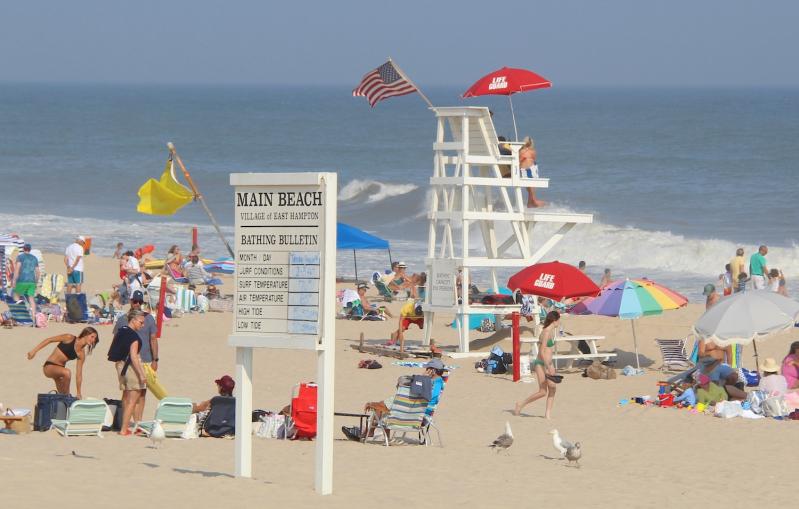I was saddened to learn that Fred Yardley has passed away. Fred and his family have been a cornerstone in East Hampton for generations. The Star’s obituary on Oct. 19 captured well the essence of one of East Hampton’s outstanding citizens. However, it missed a critically important aspect of his life by and in the sea.
I had known Fred for as long as I can remember. As a child, sometime in the mid-1950s, my mother took me to Fred at the Main Beach lifeguard stand. “Fred, this is my son Chris, please keep an eye on him and help him to learn the ocean.”
Most people do not understand the changes that sitting by the sea — four months a year, day in and day out, for decades — do to your knowledge of the ocean’s waves and currents. Fewer put their knowledge to work. Fred Yardley was a master of the waves and the sea.
Growing up in East Hampton, I reached puberty among a small and legendary group of lifeguards — arguably the best of the best along the East Coast. They were led by Fred at Main Beach and his brother, Bob, down the beach at the Maidstone Club. During the 1960s, Fred assembled a world-class group of lifeguards that included Bob Streck, Paul Amaden, George Kennedy, Richy Wilson, Big John Cavagnaro, and a few others. These guys were the strongest and best ocean swimmers of their day.
In the mid-to-late-1950s, Fred and Bob pioneered an unusual and largely unique style of body surfing (“the Main Beach Technique”) that was adopted by this group and other local acolytes, including me and my close friends Jimmy Driscoll, Phil Sprayregan, and Dennis Mahoney, who were East Hampton lifeguards.
The Main Beach Technique involved a single fin and a swimming start outside the line of waves. As a large wave approached, you swam with maximum effort and, as the crest passed below, you executed a final butterfly stroke to move the center of gravity into your chest and shoulders. This final action propelled you over and onto the face of the wave. At this point, the Main Beach Technique called for you to immediately grab your wrists under your stomach to essentially create two parallel rails that would slightly elevate you over the wave’s face.
Finally, once the wave was caught, you raised your head above the water to face the beach and jetted down the face of the wave as it crumbled in foam over your waist and legs. This last stage left just your smiling face and shoulders protruding out of a wall of foam as the wave carried you onward to shore.
Over countless summers, I watched the Yardley boys and learned their technique. Fred taught me much about the ocean, including two very important lessons. First, spend a lot of time studying the waves and the breaks and the currents (“seapooses”) until you fully understand what is happening in the water. Then use the sea to get you out beyond the break and then safely bring you back in. Second, if rumbled, go completely limp — you will sink below the foam and the wave will pass. Both are easier said than done.
Fred and his crew were the original big-wave body riders on the East Coast. Starting in the ‘50s, well before and throughout the early years of Atlantic board surfing, Fred was practicing what Wikipedia describes as the “purest form of surfing.” We are not talking about riding the harmless waves normally available under a Main Beach white or blue flag condition. We are talking about huge red and no-flag East Coast monsters.
As a 14-year-old beach boy at Main Beach in 1966, I especially remember one late summer’s day. From my home on Ocean Avenue, I could hear the tremendous crash of waves. As I approached the Main Beach “hill,” there was no flag flying under strong offshore winds.
Arriving at the beach, I knew this was to be a very special day. Down at the stand, Fred had been joined by his brother, Bob, together with Amaden, Cavagnaro, Kennedy, Wilson, and a huge guy they called “the Gladiator.” Bob Yardley came to Main Beach to ride the waves with Fred only on the biggest of days. This was one of them. The stand had been moved back, and beyond it was the most beautiful sight — giant, Hurricane-compliant, 8-to-10-foot-plus waves cresting about 150 yards from the shore with the remnants of the previous three waves still making their way to the beach.
Around 10 a.m. the group grabbed their fins and made for the surf. A more awesome sight is hard to describe. Man after man, wave after wave, this hardy group conquered the best that the Atlantic could throw at them. The terrifying reality of seeing Fred and his team, heads high, hydroplaning with their arms folded under their bodies down these humongous waves was indeed a sight. A sight that once seen is never forgotten.
This was just one of many big body-surf-riding days repeated throughout my youth and young adulthood. By age 14, I was fortunate to have learned from and was body surfing alongside these legendary men, and this was just the start.
Fred and Bob Yardley pioneered the Main Beach style of body surfing. To my knowledge, East Hampton was where it started and where it is still practiced. I have body surfed all over the world, and to this day I have found the Yardley boys’ body-surfing technique to be virtually unique.
This is how I remember Fred and his legendary East Hampton lifeguard cohorts. The best of the best, the purest of the pure, true Bonac masters of the sea. This is the “why” of Fred’s daily pilgrimage to Main Beach to “check out the waves.” Just for the joy of it. R.I.P., Fred.
Chris Reutershan lives in Bel Air, Md.

